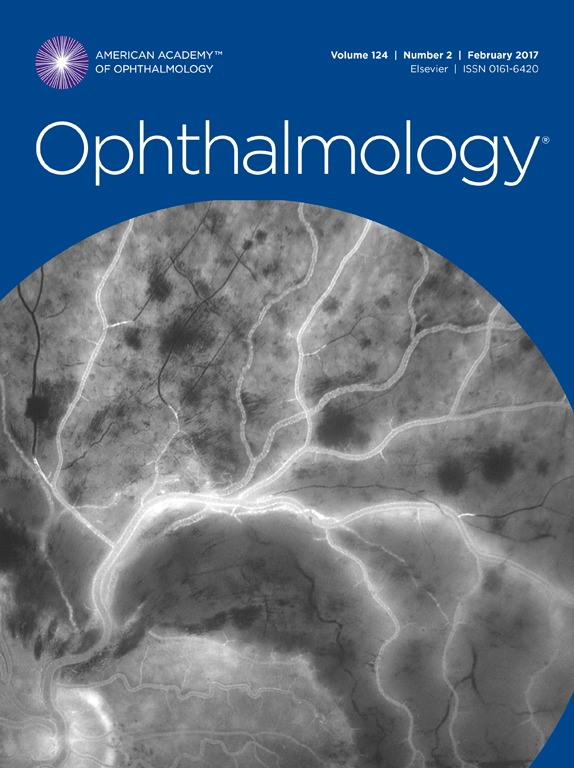Investigation of Sickle Cell Retinopathy in Pediatric and Adolescent Patients Enrolled in a Large Cohort Study
IF 13.1
1区 医学
Q1 OPHTHALMOLOGY
引用次数: 0
Abstract
Purpose
Sickle cell disease results in vaso-occlusion and hemolysis, leading to ophthalmic and systemic complications. In the eye, these processes initiate retinal ischemia and neovascularization resulting in sickle cell retinopathy (SCR). Hydroxyurea therapy increases fetal hemoglobin (reducing ischemia), and chronic blood transfusions (CTXN) reduce strokes in children with abnormally high intracranial vessel velocities. It is not known if these treatments reduce retinopathy. Our hypothesis is that hydroxyurea and CTXN lower the risk of the development and slow the progression of retinopathy.
Design
Using a large longitudinal cohort study, we determined the prevalence of SCR among pediatric and adolescent patients with sickle cell disease and the effects of disease-modifying therapy on reducing the prevalence and severity of sickle cell retinopathy.
Participants
We included all eye examinations of participants (age 10-18 at time of initial eye exam) at a single site from the Sickle Cell Research and Intervention Program cohort between October 2010 and September 2022. Patients without a dilated eye exam were excluded.
Methods
At 10 years of age, yearly ophthalmologic assessments began for patients with hemoglobin SC disease and every other year for other sickle cell genotypes. Two ophthalmologists reviewed all 2237 eye examination results.
Main Outcome Measures
We obtained patient age, sex, sickle genotype, treatment received for sickle cell retinopathy, duration of exposure to sickle cell disease-modifying therapy, and hematologic indices (fetal hemoglobin and hemoglobin concentration) and abstracted data regarding SCR, severity grading, and treatment.
Results
We observed that pediatric and adolescent patients with sickle cell disease receiving hydroxyurea therapy were 29% less likely to demonstrate SCR. Of those receiving hydroxyurea, 107 of 351 patients (30%) had SCR as compared with the 118 of 279 patients (42%) not receiving hydroxyurea (P = 0.0028). Patients receiving CTXN were 68% less likely to develop SCR. Of those, 20 of 121 patients (17%) had retinopathy as compared with the 205 of 509 patients (40%) not receiving CTXN (P < 0.001).
Conclusions
Our data from one of the largest cohorts of pediatric and adolescent patients with sickle cell disease support widespread use of hydroxyurea, CTXN, or both. We found that these therapies are associated with a smaller number of patients demonstrating SCR.
Financial Disclosure(s)
Proprietary or commercial disclosure may be found in the Footnotes and Disclosures at the end of this article.
镰状细胞视网膜病变在儿童和青少年患者中的调查纳入了一项大型队列研究。
目的:镰状细胞病导致血管闭塞和溶血,进而导致全身并发症。在眼睛中,这些过程可导致视网膜缺血和新生血管形成,导致镰状细胞性视网膜病变,根据严重程度可分为非增殖性视网膜病变和增殖性视网膜病变。羟基脲治疗可增加胎儿血红蛋白(减少缺血),慢性输血可减少颅内血管流速异常高的儿童中风。然而,没有足够的证据来确定这些治疗是否能减少视网膜病变。我们的假设是羟基脲和慢性输血降低了发展的风险,减缓了增殖性视网膜病变的进展。设计:通过一项大型纵向队列研究,我们确定了镰状细胞视网膜病变在儿童和青少年镰状细胞病患者中的患病率,以及疾病改善治疗对降低镰状细胞视网膜病变患病率和严重程度的影响。参与者:我们纳入了2010年10月至2022年9月镰状细胞研究和干预项目队列中单个地点参与者的所有眼科检查。纳入的患者在首次眼科检查时年龄为10-19岁。我们从队列数据库中获取患者的年龄、性别、镰状细胞性视网膜病变的基因型、接受镰状细胞性视网膜病变的治疗、接受镰状细胞疾病改善治疗的持续时间、血液学指标(胎儿血红蛋白和血红蛋白浓度),并提取有关镰状细胞性视网膜病变、严重程度分级和治疗的数据。结果:我们观察到,接受羟基脲治疗的儿童和青少年镰状细胞病患者发生镰状细胞视网膜病变的可能性降低29%。在羟脲治疗组中,107/351(30%)患者有镰状细胞视网膜病变,而未使用羟脲治疗组的118/279(42%)患者有镰状细胞视网膜病变(p=0.0028)。在接受CTXN治疗的患者中,20/121(17%)有视网膜病变,而未接受CTXN治疗的患者中205/509(40%)有视网膜病变(结论:我们从最大的儿童和青少年镰状细胞视网膜病变患者队列中获得的数据支持羟基脲和/或慢性输血治疗的广泛使用。我们发现,这些疗法与少数患者发生镰状细胞视网膜病变和进行性视网膜病变有关。
本文章由计算机程序翻译,如有差异,请以英文原文为准。
求助全文
约1分钟内获得全文
求助全文
来源期刊

Ophthalmology
医学-眼科学
CiteScore
22.30
自引率
3.60%
发文量
412
审稿时长
18 days
期刊介绍:
The journal Ophthalmology, from the American Academy of Ophthalmology, contributes to society by publishing research in clinical and basic science related to vision.It upholds excellence through unbiased peer-review, fostering innovation, promoting discovery, and encouraging lifelong learning.
 求助内容:
求助内容: 应助结果提醒方式:
应助结果提醒方式:


